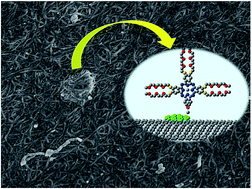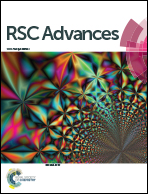Hybrid materials of pyrene substituted phthalocyanines with single-walled carbon nanotubes: structure and sensing properties
Abstract
Hybrid materials of single walled carbon nanotubes (SWCNT) were obtained by their non-covalent functionalization with asymmetrically polyoxyethylene substituted phthalocyanines (MPc-py (M = Cu, Co, 2H)) bearing one pyrene group as a substituent. The attachment of MPc-py molecules onto the SWCNT surface have been confirmed using Raman spectroscopy, SEM, TEM and thermogravimetric analysis. The pyrene substituents were introduced to the phthalocyanine macrocycle in order to improve π–π interaction between the MPc-py and SWCNT. The effect of the central metal on the formation and sensor properties of the MPc-py within the hybrids has been verified. It has been shown that the electrical response of the hybrid films to ammonia vapor in the concentration range of 10–50 ppm changes in the following order CuPc-py > CoPc-py > H2Pc-py, which was found to be in good correlation with the amount of phthalocyanine molecules adsorbed onto the SWCNT walls, as estimated by thermogravimetric analysis (TGA).


 Please wait while we load your content...
Please wait while we load your content...